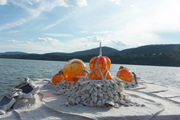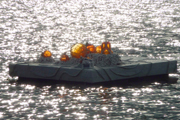
When Henry Hudson first landed in New York, New York Harbor was home to 350 miles of oyster reef spanning the distance between Coney Island and Poughkeepsie. By the turn of the twentieth century, the one time "Oyster Capital of the World" was no more as its oyster population fell to zero due to over-harvesting, pollution, and disease.
New York City is about to launch a large-scale campaign to restore its oyster beds by creating shoreline protection and habitat for over 200 forms of aquatic life. One artist, Mara G. Haseltine, has joined the fight.
She knew, with no oyster reefs left, and no oyster shells suitable for oyster colonization that alternatives must be found. Alternatives that would not employ plastic which photo degrade in water, or concrete, which creates fly ash and holes in the ozone layer.
Haseltine's "Oyster Island: A Future Substrate for Aquatic Life" is a floating, embellished, raft-like monument to her past five years of research blending art and science to restore oyster beds in New York’s estuary systems. "Oyster Island: A Future Substrate for Aquatic Life" is anchored in the Hudson River at Garrison Landing, New York. Its purpose is to blend ecologically sound planning with a sort of magical esthetic. I say magical, because the work looks like an underwater city for mermaids and other strange sea creatures. There's even a monument to the mermaid on one corner complete with a light powered by a small solar panel so it can glow at night. By using a symbol such as a mermaid to represent aquatic life, Haseltine reminds us of our earliest memories of the wonders of the sea.
Haseltine is quoted as saying: "We are constantly bombarded with horrific statistics and images of what will happen in the future. With this kind of fantastical imagery, I am creating the slate for a beautiful future."
Additionally, by placing this work directly across the river from West Point, a cluster of stone buildings that looks like something between a castle-like fortress, Haseltine enhances the ages old look of "Oyster Island." In the immediate aquatic surroundings of "Oyster Island" are the remnants of a decrepit old pier and some sort of sunken fuel or storage tank that by their juxtapositions contemporizes this work, and in turn, gives it a much broader purpose and appeal. As a result, one can’t help but feel the hope Haseltine has for a peaceful existence where all living things are afforded a fair and equal chance at survival. But this is not the case today, as we all know too well how profit comes at a price. So it is up to the few to find creative ways to stem the tide like Haseltine, and inspire other thinkers and planners.

This approach to art making Haseltine calls "geotherapy, which is a multi-disciplinary practice aimed at providing therapy to an ailing biosphere. Often, this approach means looking to the past to see into a healthy future."
To fabricate her sculptures, Haseltine only uses non-polluting, non-toxic materials such as crushed marble, unglazed porcelain, hemp, glass and wood that create no further harm to their immediate environment. She has researched and tested all of the materials to be used with Cornell Marine Exchange; the Global Coral Reef Alliance at the site of the first solar powered oyster reef in College Point Queens which grows its own calcium carbonate substrate; the NY/ NJ Baykeepers; and her students at the New School and Parsons. Tests include submerging all of the aforementioned materials into vats of oyster babies or “spat” to see which surfaces they prefer to land on.
The use of color in these works is also carefully planned. Orange, for instance, is seen as a healing color Hindu mythology. It is also a warm color, and when placed in an environment that is largely grays and cool colors, Haseltine draws attention to her goals.
In finalizing her materials she intends to use, Haseltine confers with the Department of Environmental Conservation of New York City. There, she will discuss her selection of biocompatible materials for when the sculpture is submerged. I find this to be the most compelling aspect of the artist’s work -- this intention on a purely conceptual basis, to place these sculptures under the sea to be colonized by aquatic life. The crushed marble the artist uses to coat the surfaces of her sculptures, as the artist states: "Is an ideal surface for the attachment of oyster larvae and a sustainable form for the creation of a new reef."
A sister sculpture to "Oyster Island" can be seen on Governor’s Island. “Enchanted Oyster Sweet spot: A Future Substrate for Aquatic Life” is a site-specific sculpture that works as a wind chimes. And as winds chimes often do,
Haseltine’s work here attracts attention while the aquatic references extends the awareness of the immediate environment to all who happen by. Governor’s Island is currently NYC's Mecca for Oyster reef restoration.
There is no better place to celebrate the return of the sustainable oyster reef, than there. Haseltine is currently working on a recipe book that details how others can create their own oyster habitats. This helps to insure that all of the materials used and submerged will be incorporated into a living vital reef, or naturally disintegrate leaving no toxic residue behind. "My goal is that in one hundred years all that will be left is healthy, vibrant reef and a restored estuary system with no sign of human intervention."
